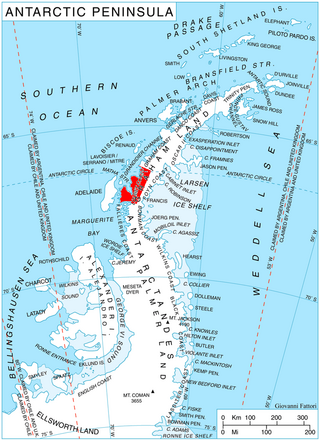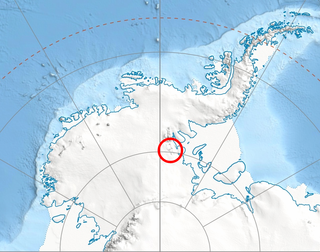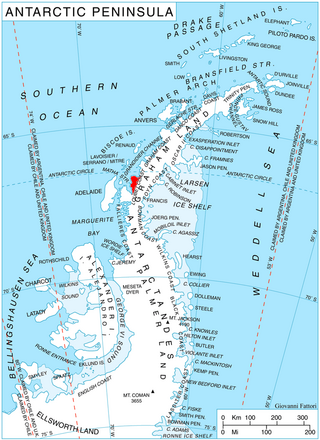Related Research Articles

The Scullin Monolith is a crescent-shaped rock fronting the sea 6 km (3.7 mi) west of the similar Murray Monolith, and 8 km (5.0 mi) from Torlyn Mountain, in Mac. Robertson Land, Antarctica. It is a steep massif of metasedimentary gneiss and granitic origin, with the adjacent coastline consisting of 40 m high ice cliffs. The monolith rises steeply to extend from 435 m high Mikkelsen Peak westward in a crescent that forms Douglas Bay.
Mikkelsen Bay is a bay, 15 nautical miles wide at its mouth and indenting 10 nautical miles, entered between Bertrand Ice Piedmont and Cape Berteaux along the west coast of Graham Land, Antarctica.

The Prince Charles Mountains are a major group of mountains in Mac. Robertson Land in Antarctica, including the Athos Range, the Porthos Range, and the Aramis Range. The highest peak is Mount Menzies, with a height of 3,228 m (10,591 ft). Other prominent peaks are Mount Izabelle and Mount Stinear. These mountains, together with other scattered peaks, form an arc about 420 km (260 mi) long, extending from the vicinity of Mount Starlight in the north to Goodspeed Nunataks in the south.
The Scott Mountains are a large number of isolated peaks lying south of Amundsen Bay in Enderby Land of East Antarctica, Antarctica. Discovered on 13 January 1930 by the British Australian New Zealand Antarctic Research Expedition (BANZARE) under Sir Douglas Mawson. He named the feature Scott Range after Captain Robert Falcon Scott, Royal Navy. The term mountains is considered more appropriate because of the isolation of its individual features.
On the continent of Antarctica, the Aramis Range is the third range south in the Prince Charles Mountains, situated 11 miles southeast of the Porthos Range and extending for about 30 miles in a southwest–northeast direction. It was first visited in January 1957 by Australian National Antarctic Research Expeditions (ANARE) southern party led by W.G. Bewsher, who named it for a character in Alexandre Dumas' novel The Three Musketeers, the most popular book read on the southern journey.
Behaim Peak is a conspicuous pyramid-shaped rock peak, 1,150 metres (3,770 ft) high, at the south extremity of the mountains separating Meridian Glacier and Doggo Defile, on the west side of the Antarctic Peninsula. It was photographed from the air by the Ronne Antarctic Research Expedition in November 1947, and surveyed from the ground by the Falkland Islands Dependencies Survey in December 1958. The peak was named by the UK Antarctic Place-Names Committee after Martin Behaim, a German cosmographer and navigator who is credited with the first adoption of the astronomer's astrolabe for navigation at sea, in 1480.
Bingham Peak is a sharp peak, 1,540 metres (5,050 ft) high, located 2.5 nautical miles (5 km) southeast of Springer Peak in the Heritage Range, Ellsworth Mountains. It was mapped by the United States Geological Survey from ground surveys and from U.S. Navy air photos, 1961–66, and named by the Advisory Committee on Antarctic Names for Joseph P. Bingham, an auroral scientist at Eights Station in 1965.

Brunvoll Glacier is a broad glacier flowing north to the coast between Murray Monolith and Torlyn Mountain on the east and Scullin Monolith and Mikkelsen Peak on the west. The name was suggested by Bjarne Aagaard for the brothers Arnold and Saebjorn Brunvoll, Norwegian whaling captains who explored along this coast in the Seksern in January 1931.

The Creswick Peaks, in Antarctica, form an impressive mountain massif with several peaks, the highest at 1,465 metres (4,800 ft), standing at the northeast side of Moore Point between Naess Glacier and Meiklejohn Glacier, and 3 nautical miles (6 km) inland from George VI Sound on the west coast of Palmer Land.

Kukri Hills is a prominent east-west trending range, about 25 nautical miles (46 km) long and over 2,000 metres (6,600 ft) high, forming the divide between Ferrar Glacier on the south and Taylor Glacier and Taylor Valley on the north, in Victoria Land, Antarctica. They are south of the Asgard Range, east of the Quartermain Mountains and north of the Royal Society Range.
Strover Peak is a low rock peak along the coast of Antarctica, standing 6 nautical miles (11 km) west-northwest of Mount Caroline Mikkelsen. Mapped by Norwegian cartographers from air photos taken by the Lars Christensen Expedition, 1936–37, and named "Svartmulen". Renamed by Antarctic Names Committee of Australia (ANCA) for W.G.H. Strover, radio supervisor at Davis Station in 1963 and a member of the ANARE party that surveyed this feature. Acceptance of Strover Peak curtails the repetitive use of "Svart" (black) in Antarctic names.

Drummond Glacier is a glacier 10 nautical miles (18 km) long and 2 nautical miles (4 km) wide, on the west coast of Graham Land, situated south of Hopkins Glacier and flowing west-northwest between Voit Peak and Sherba Ridge into Darbel Bay east of Sokol Point.
Moider Glacier is a glacier flowing west into the east side of Dalgliesh Bay, Pourquoi Pas Island, in Marguerite Bay, Antarctica. It was named by the UK Antarctic Place-Names Committee in 1979 in association with nearby Perplex Ridge; the word "moider" can be a synonym for "perplex".

Mikkelsen Harbour is a small bay indenting the south side of Trinity Island between Skottsberg Point and Borge Point, in the Palmer Archipelago, Antarctica. It provides excellent anchorage for ships, and was frequently used by sealing vessels in the first half of the nineteenth century and by Norwegian whaling vessels at the beginning of the twentieth century.
Hamm Peak is a small rock peak just back from the coast of Antarctica, standing close south of Strover Peak and 6 nautical miles (11 km) west-northwest of Mount Caroline Mikkelsen. It was first mapped by Norwegian cartographers from air photos taken by the Lars Christensen Expedition, 1936–37, and was named by the Antarctic Names Committee of Australia for G.F. Hamm, officer in charge at Mawson Station in 1968, who established a survey station on the feature.

Henderson Glacier is a glacier approximately 7 nautical miles long in the Enterprise Hills of the Heritage Range, Antarctica. It flows northeast from Schoeck Peak and Hoinkes Peak to enter Union Glacier just east of Mount Rossman. Henderson Glacier was mapped by the United States Geological Survey from surveys and U.S. Navy air photos 1961–66, and was named by the Advisory Committee on Antarctic Names for Felix E. Henderson, a United States Antarctic Research Program meteorologist at Eights Station in 1965.
Matthews Peak is a prominent peak, rising to 1,100 metres (3,600 ft) northwest of Statham Peak in the southwest part of Perplex Ridge, Pourquoi Pas Island, in Marguerite Bay, Antarctica. It was named by the UK Antarctic Place-Names Committee in 1979 after David W. Matthews, a British Antarctic Survey geologist on Stonington Island, 1965–67, who worked in the area.

McCance Glacier is the 30-km long and 5 km wide glacier draining the Hutchison Hill area on the west slopes of Avery Plateau on Loubet Coast in Graham Land, Antarctica. It flows north-northwestwards along the west side of Osikovo Ridge, Kladnitsa Peak and Rubner Peak and enters Darbel Bay.

Sölch Glacier is a glacier on the Pernik Peninsula of the Loubet Coast in Graham Land, flowing west to Salmon Cove just north of Kanchov Peak on the east side of Lallemand Fjord. It was mapped from air photos taken by the Falkland Islands and Dependencies Aerial Survey Expedition, 1956–57, and named by United Kingdom Antarctic Place-Names Committee for Johann Sölch (1883–1951), an Austrian glacial geologist and glaciologist.
References
- ↑ "Mikkelsen Peak". Geographic Names Information System . United States Geological Survey, United States Department of the Interior . Retrieved 2013-09-24.
![]() This article incorporates public domain material from "Mikkelsen Peak". Geographic Names Information System . United States Geological Survey.
This article incorporates public domain material from "Mikkelsen Peak". Geographic Names Information System . United States Geological Survey.